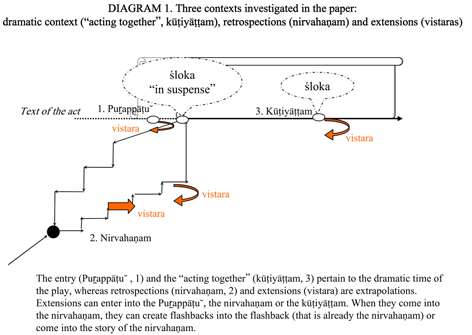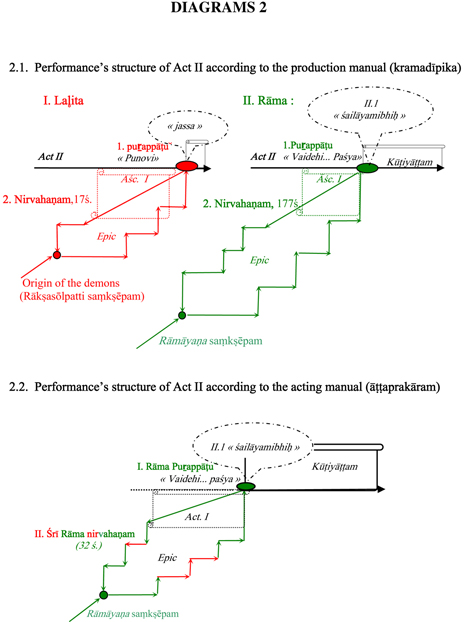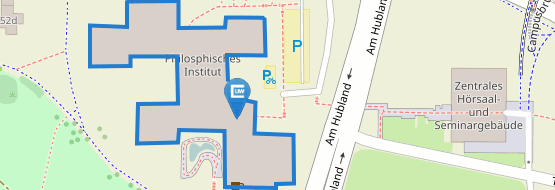Diagrams
See H. Moser’s graph in »Mantrāṅkam: The Third Act of Pratijñāyaugandharāyaṇam in Kūṭiyāṭṭam«. Bulletin d’Études Indiennes 17–18 (1999–2000): 566, whose form serves as the basis for the graphs bellow.
CLICK HERE for an enlargement of Diagram 1 (PDF)
CLICK HERE for an enlargement of Diagram 2 (PDF)
CLICK HERE for an enlargement of Diagram 3 (PDF)
The performance text starts in Kūṭiyāṭṭam style with Hanumān’s entry (puṟappāṭu˘): »here and now« (»samprati hi«), Śrī Hanumān enters in Laṅkā. The first verse (»mainākaṃ nāgakanyā«) leads to Hanumān’s retrospection (nirvahaṇam), particular to the kūttu. Knitted together by 156 verses, it takes four or five days to perform. Inspired by Vālmīki’s epic, it mainly deals with Hanumān’s story and thus takes »Hanumān’s colour«. But its opening by the Rāmāyaṇa saṃkṣēpam (Rāmāyaṇa’s summary), linked to Śrī Rāma’s story, makes Hanumān appear as Śrī Rāma’s messenger. Then, we gradually reach the text of the play. Hanumān enters in Laṅkā (»laṅkāṃ prāpto ’smi« Āśc. VI.1) and discovers the island’s beauty. The »yāni yāni« verse in suspense (VI.2) launches the last part of the red demon-coloured nirvahaṇam used in the Battle at the door (Tōraṇayuddham, Abhiṣ. III), which shows how the demon’s place consists of the divine Nandana garden (since this retrospection is short, it has no series of questions – anukramam).
Then Hanumān enters the garden – ritual dance (kriya). He discovers Sītā, listens to her lamentation and sings the praises of her beauty. This part, in prose, is done by a quick combined chanting – kūṭicollal – until Hanumān salutes Sītā through namaskāraṃ. Here the Nampyār Tamiḻ also enters into the performance for the first time.
Then, a verse (»putaṃ punāsi«, VI.6) in which Sītā is compared to the Ganges gives rise to the »Origin of the Ganges« and the »Origin of the Ocean« (gaṅgayuṭe ulppattiyum sagarōlpattiyuṃ nirvahaḥam), inspired by Vālmīki’s epic and the Brahmānda Purāṇa.
We then reach the last, important part of the act: Sītā, who has some doubts about Hanumān’s identity, asks the messenger how he met Rāma. To answer this question, Hanumān proceeds in three parts, including the previous acts of the play and different retrospections or part of retrospections found in the Rāmāyaṇa repertoire. These are all intricate in a complementary manner between two consecutive verses (VI.6–7).
(1) We start from the monkey side – Hanumān’s side – with the origins of the monkeys (vānarōlppatti) and the first twenty-five verses of Sugrīva’s retrospection found in the Act of Bāli’s death (Bālivadham, Abhiṣ. I). But Sītā still asks: »Then?« (»tado tado«). Then Hanumān pronounces what we call the magic words of Kūṭiyāṭṭam: »at that time« (»tatastasminkāle / samayatiṅṅal«). Those words give birth here to the giant retrospection (mahanirvahaṇam, 187 verses):
(2) Starting, again, with the summary of Rāmāyaṇa (Rāmāyaṇa saṃkṣēpam), the retrospection first shows Rāma’s side through the retrospection for act II of the play (including act I mixed with other sources), and act II itself (Act of Śūrpaṇakhā). It continues with Rāvaṇa’s side through parts of the retrospections for act III and for act IV (including the first part of act III, Āśc. III.5–15) and finally, the retrospection for act V, including the second part of act III (Āśc. III.16–33) and act IV of the play. Since the parts come in succession in a fluid manner, without returning to the drama except at the final retying point, this constitutes a giant retrospection, which ends when the demon-king Rāvaṇa keeps Sītā prisoner at the foot of the śiṃśapa tree, in the Aśōka grove.
(3) But Sītā still asks: »Then?« (»tado tado«). We then follow Śrī Rāma’s reaction to the abduction through the last part of act III that began earlier (Āśc. III.34–42) and through Śrī Rāma’s retrospection for Abhiṣ. I, linked to the end of Sugrīva nirvahaṇam that started the full process: Hanumān meets Rāma from the monkey side. He answers Sītā’s question in this way.
Then, Hanumān’s words and actions make Śrī Rāma enters into the kūttu: Hanumān describes Rāma (VI.7), performs the depiction »from head to foot« (kēśādipādam) of Śrī Rāma and ritual dance (kriya) again. He enacts Śrī Rāma’s despair after Sītā’s abduction till the princess asks him to stop (VI.8–13). He then gives the ring to Sītā – second Nampyār Tamiḻ and second and last combined chanting, kūṭicollal, until the last verse.
This last verse (»rakṣōvadham«) yields a special extension (vistara) that foretells the story’s future: the Battle at the door (Tōraṇayuddham, Abhiṣ. III). The nampyār finally summarizes the whole kūttu through the tamiḻ.




![Diagram 3 - Diagram 3: An account of retrospections in the »Kūttu of the ring« (Aṅgulīyāṅkam Kūttu, Āśc. VI), according to the āṭṭaprakāram (Piṣarōṭi 1988 [1967]: 184–404) and the temple practice](/fileadmin/04050200/Women_Performer/Johan/Diagrams/DIAGRAM_3.jpg)
